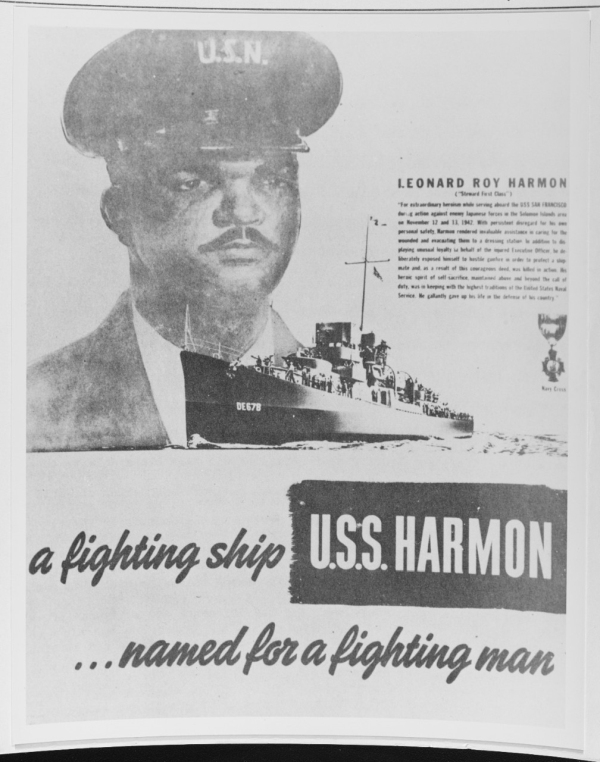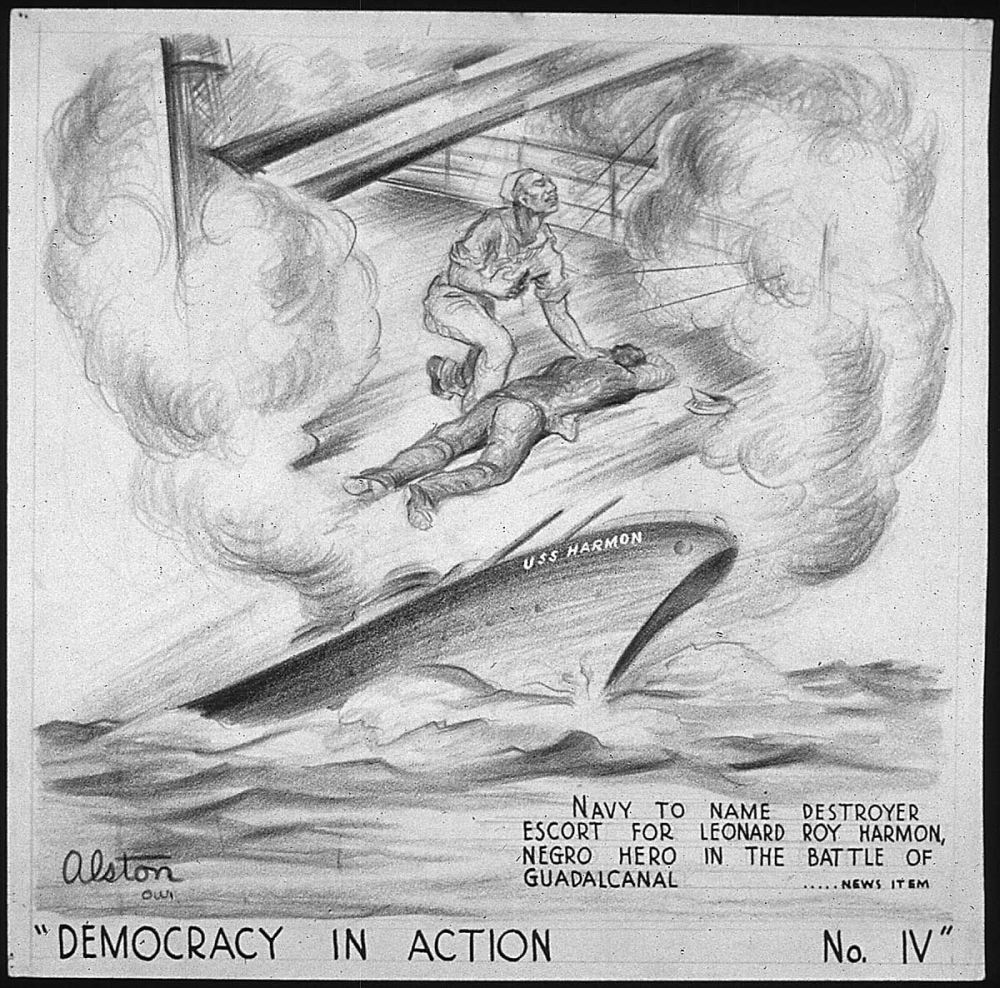Leonard Roy Harmon (1917-1943)
Youth
Roy Leonard Harmon was born on 21 January 1917 in Cuero, Texas. He was the son of Cornelius and Naunita Harmon. He graduated from Daule High School and during the Great Depression he helped with a variety of chores in and around a historic property in Cuero. On 3 December 1937 Elene Ross gave birth to a son, although they were not married. On 10 June 1939 he entered service with the Navy in Houston. He followed training in Norfolk, Virginia, and reported for duty on 28 October 1939 on the heavy cruiser USS San Francisco, which was also docked there. Aboard this vessel, he rose to Mess Attendant First Class. Being an Afro-American, there were no other options available to him.[1]

Poster with Leonard Roy Harmon and the ship named after him. Source: Naval History and Heritage Command
USS San Francisco
The ship was commissioned on 10 February 1934. The San Francisco was spared the worst disasters of the Japanese attack on Pearl Harbour, although she was berthed there too. The ship transferred machinegun ammo to the minelayer USS Tracy (DM-19) which was under attack by Japanese aircraft while crew members went aboard the USS New Orleans to help with the anti-aircraft guns. Other crewmembers fought back with available guns and machine pistols. The ship was prepared for action.[2] After the attack on Pearl Harbour the ship contributed to the battle in the Pacific. The Battle for Guadalcanal started on 12 November 1942 with the Japanese air attack on the American warships, which protected the transport ships which were putting reinforcements ashore at Lunga Point, in the north of the island. After a report came in about an imminent Japanese air raid, the ships left at 13:18 hours. Fifty minutes later the attack started with 21 Japanese aircraft.[3]
Eight minutes later a damaged torpedo aircraft smashed into USS San Francisco. The aircraft struck command post Battle I, turned around it and went overboard but its deadly cargo did not explode. The fire control and the ship’s radar were put out of action to the attack, command post Battle II caught fire. 15 men were killed, 29 were injured and one was missing. The injured were transferred to the transport ship USS President Jackson (AP-37). Later a report came in about an approaching Japanese surface fleet. Consequently it was decided to turn the ships around. Meanwhile the repairs on the USS San Francisco were continued and the command post Battle II was put back in action again.[4]
Japanese attack
After midnight, on 13 November, the USS San Francisco sailed, with a heavy cruiser, three light cruisers, and eight destroyers, north of the island Guadalcanal. At 01:25 hours the Japanese fleet was spotted at about 15.5 miles to the northwest. At 01:48 the San Francisco opened fire at her target. In the ensuing chaos, the San Francisco fired at USS Atlanta as well, causing severe damage.[5] The San Francisco was also under Japanese fire. The navigation deck was hit and the command of the vessel was transferred to Battle II. However, this too was hit soon after and again command of the ship was was lost. Only after the enemy stopped firing the San Francisco also broke off the attack. In total 77 men were killed on USS San Francisco during the battle, including Rear Admiral Daniel J. Callaghan and Captain Cassin Young. 105 men were injured and 7 were missing. 3 of whom would be found back. The ship got hit 45 times. 22 fires had broken out and were extinguished.[6]
Harmon’s heroism
Aboard USS San Francisco, Harmon helped move the wounded to an aid station, totally disregarding his own safety. He worked together with Lyndford Bondsteel, a pharmacist mate third class. Led by medical officers he was able to provide assistance and perform simple treatments on sick or wounded crew members.[7] While the violence broke out, Harmon did his best on the deck as a stretcher bearer to bring wounded people to safety.[8] He was killed when he put himself between Bondsteel and enemy fire. For this extraordinary act of valour he was posthumously awarded the Navy Cross. The citation reads:
"The President of the United States of America takes pride in presenting the Navy Cross (Posthumously) to Mess Attendant First Class Leonard Roy Harmon (NSN: 3600418), United States Navy, for extraordinary heroism and devotion to duty in action against the enemy while serving on board the Heavy Cruiser U.S.S. SAN FRANCISCO (CA-38), during action against enemy Japanese naval forces near Savo Island in the Solomon Islands on the night of on 12 - 13 November 1942. With persistent disregard of his own personal safety, Mess Attendant First Class Harmon rendered invaluable assistance in caring for the wounded and assisting them to a dressing station. In addition to displaying unusual loyalty in behalf of the injured Executive Officer, he deliberately exposed himself to hostile gunfire in order to protect a shipmate and, as a result of this courageous deed, was killed in action. His heroic spirit of self-sacrifice, maintained above and beyond the call of duty, was in keeping with the highest traditions of the United States Naval Service. He gallantly gave his life for his country."
The San Francisco brought forth many heroes. Three Medals of Honour were awarded to crew members, including Daniel Callaghan, as well as 32 Navy Crosses, of which 22 posthumously. One of those belonged to Cassin Young. Furthermore, the vessel was awarded a Presidential Unit Citation.
USS Harmon
In addition, Frank Knox announced on 21 May 1943 that a warship would be named after Harmon. USS Harmon, a Destroyer Escort, was launched on 25 July 1943.[9] Harmon was the first Afro-American who had a destroyer named after him.[10] This was published in the Evening Star of 22 March 1943 in the following way:
Escort Vessel to Bear Name of Colored Hero
Secretary of the Navy Knox has approved the naming of a destroyer escort vessel for the colored mess attendant who lost his life in the naval battle of Guadalcanal in mid-November. The first American warship named for a colored person, it will be designated the U. S. S. Harmon.
The mess attendant was Leonard Roy Harmon, who was aboard the cruiser San Francisco during the great sea battle. Mr. Harmon, 26 [sic] son of Mrs. Naunita Harmon Carroll, Cuero, Tex. assisted throughout the engagement in caring for wounded men and removing them from battle stations to dressing stations aboard ship.
He was killed, the Navy said, when he deliberately exposed himself to hostile gun fire to protect a shipmate. The Secretary has awarded him the Navy Cross posthumously."[11]
USS Harmon came into action in the Pacific and remained in service in the American Navy until August 1965. In January 1967 the ship was sold as scrap. The name Harmon was kept alive within the American Navy, although the ship does not exist anymore.

Special guests during the commissioning of the ship USS Harmon on 25 July 1943. From left to right: Harmon’s sister, Mr. W.D. Carroll (husband of the sponsor of the ship, Mrs. Naunita Harmon Carroll), Harmon’s mother and Mrs. Paul Edwards (sister of the sponsor). Source: Naval History and Heritage Command.
Example
Harmon himself became an example for to Afro-Americans. With the following article in the Detroit Tribune on Memorial Day 1943 his sacrifice was acknowledged:
Memorial Day, 1943
[…] Many such instances of Negro heroism might be cited, including that of the Negro hero, Leonard Roy Harmon, who fought so gallantly and died so heroically in Pacific battles against the Japs that the Navy is soon to launch a U.S. destroyer named in his honor.
Such patriotism and heroism are worthy of the highest praise. It is our sincere hope that the sacrifices made by these and countless other heroic members of our race will not be forgotten after the war. We earnestly trust that in the peace which shall follow this conflict, our people and oppressed minority peoples of the earth will receive a larger measure of justice, democracy and freedom. Peace founded upon any other basis will be fruitless and of brief duration and the sacrifices we are now being called upon to make in sweat, tears and blood have been all in vain."[12]
Notes
- Handbook of Texas Online, Richard Allen Burns, "HARMON, LEONARD ROY", www.tshaonline.org/handbook/online/articles/fhady.
- Naval History and Heritage Command, San Francisco II (CA-38)1934-1959, www.history.navy.mil.
- Naval History and Heritage Command, San Francisco II (CA-38)1934-1959, www.history.navy.mil.
- Naval History and Heritage Command, San Francisco II (CA-38)1934-1959, www.history.navy.mil.
- Naval History and Heritage Command, Atlanta III (CL-51)1941-1943, www.history.navy.mil.
- Naval History and Heritage Command, San Francisco II (CA-38)1934-1959, www.history.navy.mil.
- U.S. National Library of Medicine, A Pharmacist's Mate First Class, circulatingnow.nlm.nih.gov.
- Naval History and Heritage Command, Harmon (DE-678), www.history.navy.mil.
- Handbook of Texas Online, Richard Allen Burns, "HARMON, LEONARD ROY", www.tshaonline.org/handbook/online/articles/fhady.
- Jet, 13 november 1952.
- Escort Vessel to Bear Name of Colored Hero’, Evening Star, 22 mei 1943, 5.
- ‘Memorial Day, 1943’, The Detroit Tribune, 29 mei 1943, 16.
Definitielijst
- cruiser
- A fast warship with 8,000 – 15,000 ton displacement, capable to perform multiple tasks such as reconnaissance, anti-aircraft defence and convoy protection.
- democracy
- From the Greek: demos (the people) kratein (rules). Democracy is a form of government elected by the majority of the people in which the people can check on the leaders and have the government resign in case a majority of the people no longer agrees with the government.
- Destroyer
- Very light, fast and agile warship, intended to destroy large enemy ships by surprise attack and eliminating them by using torpedoes.
- mid
- Military intelligence service.
- radar
- English abbreviation meaning: Radio Detection And Ranging. System to detect the presence, distance, speed and direction of an object, such as ships and airplanes, using electromagnetic waves.
- raid
- Fast military raid in enemy territory
- torpedo
- A weapon of war. A cigar shaped body fitted with explosives and a propulsion and control mechanism. Intended to target after launch a nearby enemy ship and disable it by underwater explosion.
Information
- Translated by:
- Thijs de Veen
- Published on:
- 19-01-2025
- Feedback?
- Send it!




